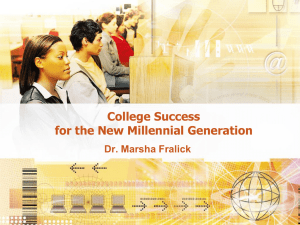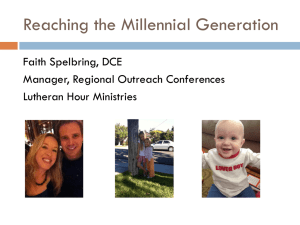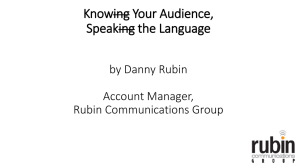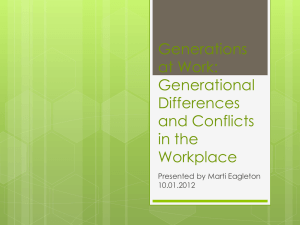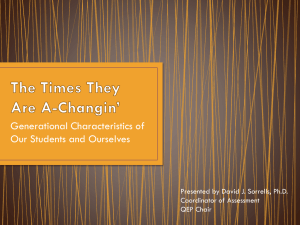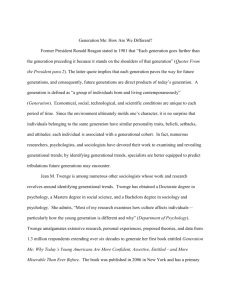- First
advertisement
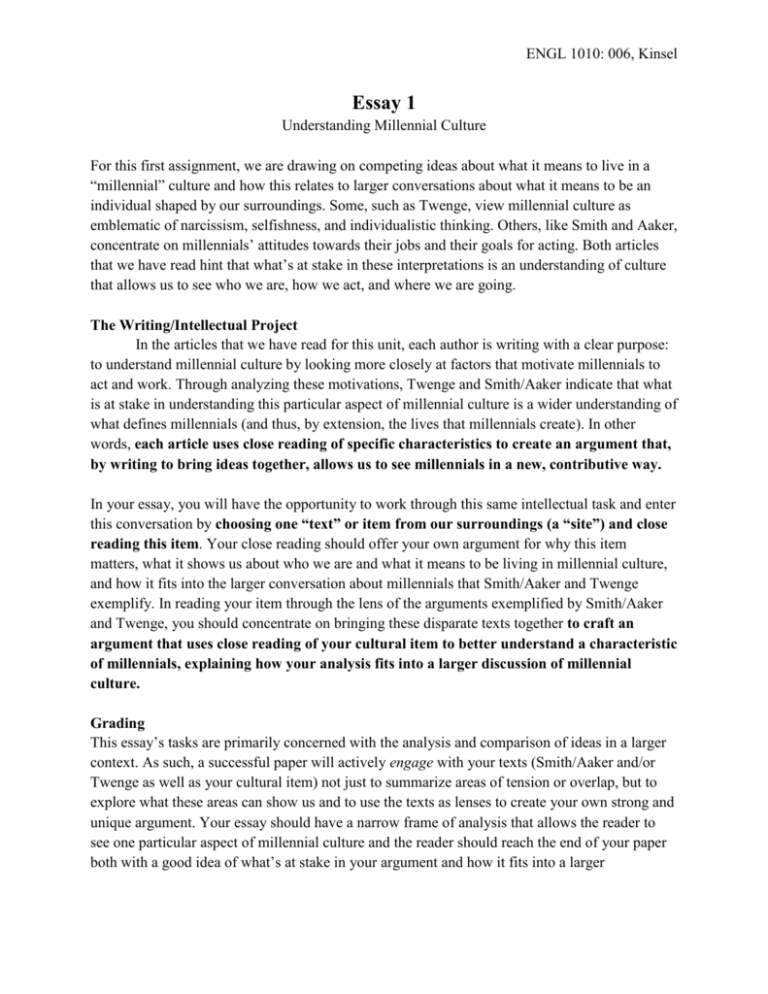
ENGL 1010: 006, Kinsel Essay 1 Understanding Millennial Culture For this first assignment, we are drawing on competing ideas about what it means to live in a “millennial” culture and how this relates to larger conversations about what it means to be an individual shaped by our surroundings. Some, such as Twenge, view millennial culture as emblematic of narcissism, selfishness, and individualistic thinking. Others, like Smith and Aaker, concentrate on millennials’ attitudes towards their jobs and their goals for acting. Both articles that we have read hint that what’s at stake in these interpretations is an understanding of culture that allows us to see who we are, how we act, and where we are going. The Writing/Intellectual Project In the articles that we have read for this unit, each author is writing with a clear purpose: to understand millennial culture by looking more closely at factors that motivate millennials to act and work. Through analyzing these motivations, Twenge and Smith/Aaker indicate that what is at stake in understanding this particular aspect of millennial culture is a wider understanding of what defines millennials (and thus, by extension, the lives that millennials create). In other words, each article uses close reading of specific characteristics to create an argument that, by writing to bring ideas together, allows us to see millennials in a new, contributive way. In your essay, you will have the opportunity to work through this same intellectual task and enter this conversation by choosing one “text” or item from our surroundings (a “site”) and close reading this item. Your close reading should offer your own argument for why this item matters, what it shows us about who we are and what it means to be living in millennial culture, and how it fits into the larger conversation about millennials that Smith/Aaker and Twenge exemplify. In reading your item through the lens of the arguments exemplified by Smith/Aaker and Twenge, you should concentrate on bringing these disparate texts together to craft an argument that uses close reading of your cultural item to better understand a characteristic of millennials, explaining how your analysis fits into a larger discussion of millennial culture. Grading This essay’s tasks are primarily concerned with the analysis and comparison of ideas in a larger context. As such, a successful paper will actively engage with your texts (Smith/Aaker and/or Twenge as well as your cultural item) not just to summarize areas of tension or overlap, but to explore what these areas can show us and to use the texts as lenses to create your own strong and unique argument. Your essay should have a narrow frame of analysis that allows the reader to see one particular aspect of millennial culture and the reader should reach the end of your paper both with a good idea of what’s at stake in your argument and how it fits into a larger ENGL 1010: 006, Kinsel conversation. In short, your essay should have a strong argument that is more than just summary and that is aware of a larger conversation and your own place within it. As always, your essay should have a clear, specific, and debatable thesis that guides your paper. Your paragraphs should work off of one another and each part of your paper should be driven by a clear sense of meaning and importance. Your conclusion should not merely summarize, but should provide a larger sense of the “so what” and importance of your argument. Also, be aware of MLA formatting and citing. Details First draft (5-6 pages) due on HuskyCT by 11:59pm on Friday, 2/6 Individual Conferences on 2/10 and 2/12 Informal Draft 2-bring to class for workshopping on Tuesday, 2/17 Final draft (6-7 pages) due on HuskyCT before class on Tuesday, 2/19 Steps to Consider 1. First, you should carefully select a piece of millennial culture—your “cultural item”— that you would like to analyze. This can be anything from a movie, to a book, to a comic strip, to a CD, to a social media site, to a website, to a picture, to a trend, to a phrase, or anything else that you can think of. The only requirement is that you should be able to articulate why this specific item represents 21st century and/or millennial culture. Your reader, for example, should have a clear idea of why this specific cultural item matters. 2. (Optional—this step may be helpful by narrowing your analysis) Choose one theme or aspect of culture to study. This theme will inform your study and will provide a narrower “lens” through which to analyze millennial culture. Examples are boundless, but include such topics as interpersonal relationships, methods of communication, family units, volunteering, selfhood, political engagement, relationships to technology, relationships to the environment, nationalism, and habits of mind. Take Twenge and Smith/Aaker as your models: Twenge approaches her study through trying to understand millennials’ emphasis on the self, while Smith and Aaker refute this reading by instead focusing on millennials’ relationship to “meaning.” Both are concerned with the larger topic of motivation, but they each also concentrate on a smaller theme. 3. Analyze your cultural item, Twenge, and Smith/Aaker, paying special attention to the ways in which they are suggesting ideas about your theme of millennial culture and what it means to be living in the 21st century. Pay attention to what each text is suggesting, and the ways in which your texts overlap or are in tension. Where are the grey areas and areas ENGL 1010: 006, Kinsel of overlap in your texts? What would Smith and Aaker say about your item? What would Twenge say? More importantly, what do you say, and how does this compare to these other voices? 4. Using your analysis of the cultural item, craft an argument that explores one particular aspect of what it means to be a millennial, making sure to articulate what’s at stake in understanding your view. How are millennials presented? What’s at stake in understanding millennials? Is there a certain aspect of your cultural item that you believe resonates with 21st-century individuals precisely because of what it suggests about being an individual? There are tons of questions that you can consider, and they can each help you to analyze what your cultural item suggests about a characteristic of millennials and how your analysis fits into the larger discussion of millennial culture. Here are some example templates of ways that you can formulate the relationship of your item (or “site” of analysis) to larger ideas: - - A social media website is a place that demonstrates ____ about ____. Comments on Instagram [refute/modify/forward] Smith and Aaker’s argument by showing that _____. The popular show Game of Thrones acts as a site through which we can see _____ about millennials. The phrase “tl;dr” is a written site of commentary that exemplifies____ about millennial culture. Combining the seemingly opposing terms “narcissism” and “meaning” allows us to better see that _____, an idea which is demonstrated in [certain characteristic or site/cultural item]. Both Smith/Aaker and Twenge fail to see that _____. This lapse in analysis is made evident in _____, showing us _____ about millennial culture.



